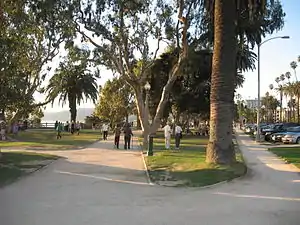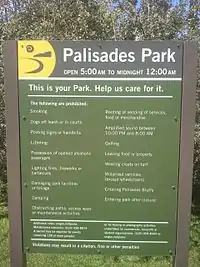Palisades Park (Santa Monica)
Palisades Park is a 26.4-acre (10.7 ha) park in Santa Monica, California. The park is located along a 1.6-mile (2.6 km) section of Ocean Avenue on top of an uplifted unconsolidated sedimentary coastal Quaternary terrace with exposed bluffs, offering views of both the Pacific Ocean and the coastal mountains.


The park extends from the Santa Monica Pier at the south to Adelaide Drive at the north. This long linear park contains public art, rose garden, and historic structures, as well as benches, picnic areas, pétanque courts, restrooms and the historic Santa Monica Camera Obscura.
Barriers discourage visitors from approaching too close to the cliffs, which are prone to erosion and landslides.[1] Private use of the park by fitness instructors has generated some controversy.[2]
Public art and historic features
The oldest structure built in Palisades Park is the Idaho Gate, a Craftsman-style archway built in 1912 and named for the adjacent street, and a distinctive Native American totem pole was donated to the City in 1926 by Walter J. Todd. After the installation of Eugene H. Monrahan's 1934 sculptural statue of Santa Monica, additional public art was installed more than fifty years later.
- Civil War cannon (1908) (terminus of Colorado Avenue and Broadway)
- Idaho Gate (1912) by Greene and Greene (terminus of Idaho Avenue)
- totem pole (circa 1925; artist unknown) (terminus of San Vicente Boulevard, Santa Monica)
- Statue of Santa Monica (1934) by Eugene H. Monrahan (terminus of Wilshire Boulevard)
- Bust of Arcadia Bandini de Baker (1987) by Masahito Sanae, near rose garden (terminus of Palisades Avenue)
- wood sculpture Gestation III (1993) by Baile Oakes (winter solstice) sunset alignmnent (terminus of Palisades Avenue)
- Sculpture Beacon Overlook (2000)] by Jody Pinto, near California Incline (terminus of California Avenue)
Park trees
The park has more than 30 species of plants and trees, including gum, yate, pine, palm, and fig trees.[3] Two stone monuments with plaques honor two noted tree experts, George Hastings and Grace Heintz, who both wrote books on the trees of Santa Monica. Spanning five decades from 1944 to 1989, the works provide five baseline studies for understanding the history and geography of the urban woodland of the park, as well as the trees in Santa Monica and neighboring portions of Los Angeles, including cemeteries, schools, colleges, and businesses.
Some of the tree species at Palisades Park include:
- Monterey cypress, Hesperocyparis macrocarpa (Hart.) Bartel
- Indian laurel fig, Ficus microcarpa L.
- rusty-leaf fig, Ficus rubiginosa Desf.
- Yate, Eucalyptus cornuta Labill.
- Murray River red gum, Eucalyptus camaldulensis Dehnh.
- Italian stone pine, Pinus pinea L.
- Canary Island date palm, Phoenix canariensis Chaub.
- European fan palm, Chamaerops humilis L.
- Mexican fan palm, Washingtonia robusta Wendl.
- Mexican blue palm, Brahea armata S. Watson
- windmill palm, Trachycarpus fortunei Wendl.
- Cuban royal palm, Roystonea regia (Kunth) O. F. Cook
- Senegal date palm, Phoenix reclinata Jacq.
References
- "Cliffs at Palisades Park are slowly crumbling from erosion". Los Angeles Times. March 23, 1995. Retrieved August 31, 2013.
- "Santa Monica weighs limits on fitness classes in Palisades Park". Los Angeles Times. January 9, 2013. Retrieved August 31, 2013.
- "Conservancy tour features history of Palisades Park". Los Angeles Times. June 9, 2010. Retrieved August 31, 2013.
External links
 Media related to Palisades Park, Santa Monica at Wikimedia Commons
Media related to Palisades Park, Santa Monica at Wikimedia Commons